The Electric Grid Still Isn't Ready for EVs and Electric Big Rigs

Image: Freightliner
The EV transition is going to impact every part of transportation in the U.S. From fire trucks to school buses, everything that uses gas and has wheels is going to have to turn into an EV. The downside to this transition is that we aren’t quite ready for it yet. Parts of the transportation industry are changing faster than grid upgrades can come. Take electric semi-trucks. Bloomberg reports that truck stops will have to have enough energy to power a small town to handle the charging needs of EV semis.
Research done by utility company National Grid shows that highway-side electric stations in 2030, if they’re similar to gas stations in the future, will require as much energy as a stadium to be able to handle the charging needs of EVs. The needs increase with the size of the EV — and charging needs for EV semi trucks will be enough to power a small town. National Grid came to conclusion by gathering data from studying the refueling needs of 71 different gas stations along highways in New York and New England. They then used the projections of EV adoptions to come up with shocking numbers.
So how will the grid handle the power needs, especially as companies like Tesla roll out EV semis capable of 500 miles of range? It can’t currently, and the reality is that we’re way behind. Bart Franey, Vice President of National Grid’s clean energy development says if the grid investments don’t start soon, the market is going to leave it behind. “We need to start making these investments now. We can’t just wait for it to happen, because the market is going to outpace the infrastructure,” he said.
It’s so bad that some businesses are already running into charging problems with the electric semis that are already on the road, like Daimler’s Freightliner eCascadia. Daimler told Bloomberg that some of their customers are finding out that the waiting period for chargers that can handle the needs of their trucks is longer than it would take for them to receive their trucks.
Essentially, we needed to start reworking the infrastructure for these things yesterday. With billions earmarked for the funding of national chargers, I’m not sure exactly what the hold up is with the infrastructure development. But it can’t come soon enough.





